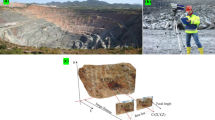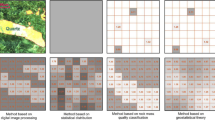Abstract
Mechanical parameters of rock mass in mining engineering feature the characteristics of spatial variability and time decay, and it plays an important role in the slope stability analysis. The mechanical behaviour of rock engineering in low in-situ stress condition is highly affected by the rock mass quality. In this paper, the distribution of geological strength index (GSI) was obtained by geostatistics-based methods to determine the spatial variability of mechanical parameters. Moreover, mechanical parameters of rock masses in open-pit mine are deteriorating continuously in the mining process. A damage model using microseism (MS) data was proposed to describe the time decay of mechanical parameters. Additionally, the dynamic programming method was used to search the rough critical slip surface and factor of safety considering the heterogeneous mechanical parameters. An example was further employed to demonstrate these proposed methods in the Dagushan open-pit mine. The results indicated that incorporation of spatial variability and time decay into mechanical parameters leaded to a fundamental change in the slope stability. Our study helps to provide detailed mechanical parameters, which contribute to a more reasonable explanation as well as provide governance measures for the rock landslides.




















Similar content being viewed by others
Abbreviations
- J v :
-
Volumetric frequency of discontinuities
- T :
-
Ratio of fracture element in rough discrete fracture network (RDFN) model of jointed rock mass
- xv, xi, di, N :
-
Estimation point, ith sampling point participating in the estimation, the distance from ith sampling point to the estimation point and exponent related the degree of variation
- m i :
-
Material constant in the Hoek–Brown method
- U, UE, UD, UM :
-
Total energy exercised by external forces on rock mass, dissipation energy and releasable strain energy, MS energy in a rock mass unit
- EUD, ED, cUD, cD, φUD, φD; D :
-
Elastic modulus, cohesion and friction of undisturbed and damaged rock mass; damage variable
- EMS, VA :
-
Source energy and apparent volume of MS event
- η :
-
Seismic efficiency
- M, G :
-
Seismic moment of MS event, stiffness of rock mass
- f s :
-
Factor of safety
- τf, τ :
-
Shear stress and shear strength
- Ri, Si :
-
Actuating forces and resisting forces
- Gm, Hi(j):
-
Auxiliary function and optimal function
- [i], {j}:
-
Stage and state point in the dynamic programming method
- P, Q :
-
Number of stage and state point
- σ1, σ2, σ3 :
-
Maximum, medium, and minimum principal stress in 3D space
- σx, σy, τxy :
-
Horizontal stress, vertical stress and shear stress in 2D space
References
Adisoma GS, Hester MG (1996) Grade estimation and its precision in mineral resources: the Jackknife approach. Min Eng 48(2):84–88
Baker R (1980) Determination of the critical slip surface in slope stability computations. Int J Numer Anal Meth Geomech 4:333–359
Bazant ZP, Belytschko TB, Chang TP (1984) Continuum theory for strain-softening. J Eng Mech 110:1666–1692
Caers J (2005) Petroleum geostatistics. Soc. of Petroleum Eng, Richardson
Cai M, Kaiser PK, Martin CD (1998) A tensile model for the interpretation of microseismic events near underground opening. Pure Appl Geophys 153:67–92
Cai M, Kaiser PK, Martin CD (2001) Quantification of rock mass damage in underground excavations from microseismic event monitoring. Int J Rock Mech Min Sci 38:1135–1145
Cai M, Morioka H, Kaiser PK, Tasaka Y, Kurose H, Minami M, Maejima T (2007) Back-analysis of rock mass strength parameters using AE monitoring data. Int J Rock Mech Min Sci 44:538–549
Cristescu ND, Hunsche U (1998) The time effects in rock mechanics. Wiley, New York
Egaña M, Ortiz JM (2013) Assessment of RMR and its uncertainty by using geostatistical simulation in a mining project. J GeoEng 8:83–90
Eivazy H, Esmaieli K, Jean R (2017) Modelling geomechanical heterogeneity of rock masses using direct and indirect geostatistical conditional simulation methods. Rock Mech Rock Eng 50:3175–3195
Fakhimi A, Fairhurst C (1994) A model for the time-dependent behavior of rock. Int J Rock Mech Min Sci Geomech Abstr 31(2):117–126
Feng XT, Zhang Z, Sheng Q (2000) Estimating mechanical rock mass parameters relating to the Three Gorges Project permanent shiplock using an intelligent displacement back analysis method. Int J Rock Mech Min Sci 37:1039–1054
Fenton GA, Griffiths VD (2008) Risk assessment in geotechnical engineering. Wiley, New York
Ferreira IO, Rodrigues DD, Santos GRd, Rosa LMF (2017) In bathymetric surfaces: IDW or Kriging? Boletim de Ciências Geodésicas 23:493–508
Griffiths DV, Huang J, Fenton GA (2009) Influence of spatial variability on slope reliability using 2-D random fields. J Geotech Geoenviron Eng 135:1367–1378
Henley S (2012) Nonparametric geostatistics. Applied Science Publishers Ltd, London
Hoek E (2007) Practical rock engineering. https://www.rocscience.com
Hoek E, Carranza-Torres C (2002) Hoek–Brown failure criterion—2002 edition. In: Proceedings of the fifth North American rock mechanics symposium, vol 1, pp 18–22
Jiang SH, Li DQ, Zhang LM, Zhou CB (2014) Time-dependent system reliability of anchored rock slopes considering rock bolt corrosion effect. Eng Geol 175:1–8
Kanit T, Forest S, Galliet I, Mounoury V, Jeulin D (2003) Determination of the size of the representative volume element for random composites: statistical and numerical approach. Int J Solids Struct 40:3647–3679
Lebert F, Bernardie S, Mainsant G (2011) Hydroacoustic monitoring of a salt cavity: an analysis of precursory events of the collapse. Nat Hazards Earth Syst Sci 11:2663–2675
Lee YK, Pietruszczak S (2008) A new numerical procedure for elasto-plastic analysis of a circular opening excavated in a strain-softening rock mass. Tunn Undergr Space Technol 23:588–599
Li DQ, Jiang SH, Cao ZJ, Zhou W, Zhou CB, Zhang LM (2015) A multiple response-surface method for slope reliability analysis considering spatial variability of soil properties. Eng Geol 187:60–72
Ma T, Tang C, Tang L, Zhang W, Wang L (2015) Rockburst characteristics and microseismic monitoring of deep-buried tunnels for Jinping II Hydropower Station. Tunn Undergr Space Technol 49:345–368
Malan D (1999) Time-dependent behaviour of deep level tabular excavations in hard rock. Rock Mech Rock Eng 32:123–155
Maranini E, Yamaguchi T (2001) A non-associated viscoplastic model for the behaviour of granite in triaxial compression. Mech Mater 33:283–293
Martin C, Chandler N (1994) The progressive fracture of Lac du Bonnet granite. Int J Rock Mech Min Sci Geomech Abstr 31:643–659
Mayer JM, Stead D (2017) A comparison of traditional, step-path, and geostatistical techniques in the stability analysis of a large open pit. Rock Mech Rock Eng 50:927–949
Myers DE (1994) Spatial interpolation: an overview. Geoderma 62:17–28
Pham HT, Fredlund DG (2003) The application of dynamic programming to slope stability analysis. Can Geotech J 40:830–847
Priest SD (1993) Discontinuity analysis for rock engineering. Chapman & Hall, London
Read J, Stacey P (2018) Guidelines for open pit slope design. CSIRO Publishing, Collingwood
Rendu JM (1978) An introduction to geostatistical methods of mineral evaluation. South African Institute of Mining and Metallurgy
Richard B (1957) Dynamic programming. Princeton University Press, 89:92
Sagasta F, Benavent-Climent A, Roldán A, Gallego A (2016) Correlation of plastic strain energy and acoustic emission energy in reinforced concrete structures. Appl Sci 6:84
Sajid A, Rudra R, Parkin G (2013) Systematic evaluation of kriging and inverse distance weighting methods for spatial analysis of soil bulk density. Can Biosyst Eng 55:1–13
Sharifzadeh M, Tarifard A, Moridi MA (2013) Time-dependent behavior of tunnel lining in weak rock mass based on displacement back analysis method. Tunn Undergr Space Technol 38:348–356
Sonmez H, Ulusay R (1999) Modifications to the geological strength index (GSI) and their applicability to stability of slopes. Int J Rock Mech Min Sci 36:743–760
Stavropoulou M, Exadaktylos G, Saratsis G (2007) A combined three-dimensional geological-geostatistical-numerical model of underground excavations in rock. Rock Mech Rock Eng 40:213–243
Tang C (1997) Numerical simulation of progressive rock failure and associated seismicity. Int J Rock Mech Min Sci 34:249–261
Tomczak M (1998) Spatial interpolation and its uncertainty using automated anisotropic inverse distance weighting (IDW)-cross-validation/jackknife approach. J Geogr Inf Decis Anal 2:18–30
Wang S, Zheng H, Li C, Ge X (2011) A finite element implementation of strain-softening rock mass. Int J Rock Mech Min Sci 48:67–76
Xie H, Ju Y, Li L (2005) Criteria for strength and structural failure of rocks based on energy dissipation and energy release principles. Chin J Rock Mech Eng 24:3003–3010 (in Chinese)
Xu N, Dai F, Liang Z, Zhou Z, Sha C, Tang C (2014) The dynamic evaluation of rock slope stability considering the effects of microseismic damage. Rock Mech Rock Eng 47:621–642
Yerry MA, Shephard MS (1984) Automatic three-dimensional mesh generation by the modified-octree technique. Int J Numer Methods Eng 20:1965–1990
Zhao Y, Yang T, Zhang P, Zhou J, Yu Q, Deng W (2017) The analysis of rock damage process based on the microseismic monitoring and numerical simulations. Tunn Undergr Space Technol 69:1–17
Zhou H, Wang C, Han B, Duan Z (2011) A creep constitutive model for salt rock based on fractional derivatives. Int J Rock Mech Min Sci 48:116–121
Zhou J, Yang T, Zhang P, Xu T, Wei J (2017) Formation process and mechanism of seepage channels around grout curtain from microseismic monitoring: a case study of Zhangmatun iron mine, China. Eng Geol 226:301–315
Zhou J, Wei J, Yang T, Zhu W, Li L, Zhang P (2018) Damage analysis of rock mass coupling joints, water and microseismicity. Tunn Undergr Space Technol 71:366–381
Zhu W, Tang C (2004) Micromechanical model for simulating the fracture process of rock. Rock Mech Rock Eng 37:25–35
Acknowledgements
This work was supported by the National Key Research and Development Program of China (2016YFC0801602 and 2017YFC1503101), the National Science Foundation of China (U1710253, 51574059 and 51574060) and the China Scholarship Council (201806080101). We would like to thank Professor Peijun Guo from McMaster University for his guidance and support, and Andy Yan, Li Xu and Dylan Liu from McMaster University for their help in English writing. We also would like to thank anonymous reviewers and the editor for constructive comments that helped improve this manuscript.
Author information
Authors and Affiliations
Corresponding author
Additional information
Publisher's Note
Springer Nature remains neutral with regard to jurisdictional claims in published maps and institutional affiliations.
Rights and permissions
About this article
Cite this article
Liu, F., Yang, T., Zhou, J. et al. Spatial Variability and Time Decay of Rock Mass Mechanical Parameters: A Landslide Study in the Dagushan Open-Pit Mine. Rock Mech Rock Eng 53, 3031–3053 (2020). https://doi.org/10.1007/s00603-020-02109-z
Received:
Accepted:
Published:
Issue Date:
DOI: https://doi.org/10.1007/s00603-020-02109-z




